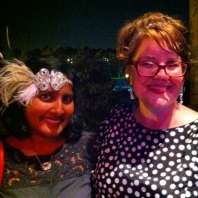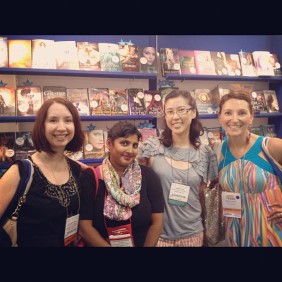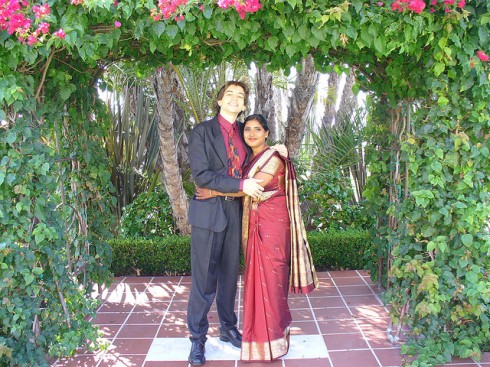As you can see, colors have changed and a new header has made this blog blossom (see what I did there? ;P). My talented friend, Elle, who is an AMAZING graphic designer, worked with me to create a header fitting the theme of this blog, as well as my own personal identity. I couldn’t have imagined something better. She also designed Allison’s header, so if you’re ever in need of a quality re-design for your blog, Elle’s your girl!
Now…on to my ALA 2012 re-cap.
I am always super glad when ALA is local (or semi-local…I still had to drive 50 minutes) – it’s truly a relief when I don’t have to contend with flying, hotel reservations, worrying about luggage limits, etc. My good friend, Allison was super awesome, and let me crash at her place, for which I’m supremely grateful!
Friday night was a whirlwind of activity, beginning with a brief foray into exhibits. Immediately upon our arrival, Joanna, Allison, and I ran into one of our favorite writers: Cindy Pon! Cindy wrote the lush, and fully engrossing Kingdom of Xia duology, Silver Phoenix and Fury of the Phoenix.
I ended up picking up most of my ARCS on opening night, and spending time chatting with some lovely folks, including Hannah Ehrlich from Lee & Low. Hannah was extremely gracious and handed me a copy of Diverse Energies a forthcoming dystopian sci-fi anthology featuring amazing writers like Cindy Pon, Malinda Lo, Paolo Bacigalupi, Ursula Le Guin, Greg Van Eekhout, and more! She also gave me Guadalupe Garcia McCall’s new book, Summer of the Mariposas, a Mexican American re-imagining of Homer’s Odyssey – I can’t wait to dig into this one!
Following exhibits, we made our way over to the Hilton where Kellie from Walden Pond Press and MaryAnn Scheuer from Great Kids Books organized a fantastic meet-up to discuss middle grade books. I met so many fabulous writers, publishers, bloggers, and librarians at this event. The best part? I got to finally meet one of my favorite librarians ever from Twitter, Sarah – who is just as charming and hilarious in person!
Lastly, it was on to the House of Blues for Little, Brown’s Dance Party celebrating the forthcoming publication of Libba Bray’s The Diviners.

Libba and I at the LBYR Dance Party ~ in keeping with THE DIVINERS Roaring 20s theme, I’m wearing a flapper headband.
Libba was showcasing her awesome dance moves (she seriously is a great dancer), and I got to talk with her for a brief while, and tell her how terrifying her new book is. She advised me to “sleep with one eye open.” Not helpful, Libba. 😉
Saturday was filled with a host of activities and sessions, beginning with Harper Collins’ Picture Book Breakfast where I got a chance to see some of the newer titles on display – I picked up a couple of books that possibly merited consideration for ALA’s Amelia Bloomer Project: Defiance by C.J. Redwine and Valkyrie Rising by Ingrid Paulson. Following the HC breakfast, I was off to an insightful focus group with Lerner Books where we discussed how libraries currently proceed with collection development for juvenile areas. At the end of the session, we were allowed to choose some books for our libraries~thank you, Lerner Books, for such a wonderful opportunity!
Later that afternoon, I went to a delightful publisher preview by Disney-Hyperion, where they showcased some incredible titles including Matthew Cordell’s new picture book, Hello! Hello!, a timely story about how social media obscures the important things in life. Andrea Davis Pinkney and her husband, Brian Pinkney are collaborating on a stunning picture book featuring vital black men who shaped African-American culture and history. I also discovered that Ms. Pinkey sings beautifully. Mo Willems closed the preview by reading aloud from his new Elephant and Piggie book.
My Saturday wrapped up with the YALSA Happy Hour at Morton’s, arranged by Allison, who served as YALSA’s Local Arrangements Chair. After that, it was a nice dinner with Michelle, Allison, and Melissa. Then we were off to the YA Blogger Meet-up, organized by YA Highway and Kelly Jensen from Stacked Books.
Sunday was equally as busy, and my highlights included the YA Coffee Klatch, a musical-chairs type affair where authors rotate around tables every 5 minutes–truly a blast. We also met up with my friend and co-worker Eveleen at the Scholastic Literary Brunch, where we were treated to tasty quiche and a lively Readers’ Theatre. Things I learned: James Dashner is a fan of Downton Abbey (I know, right?!), and Eliot Schrefer wins the award for cutest “awwww” inspiring moment (the slideshow had a picture of him being cuddled by a Bonobo chimp). Schrefer’s upcoming YA book, Endangered is set in the Congo and features a girl who must save Bonobos when a revolution breaks out. Raina Telgemeier’s forthcoming graphic novel,Drama will draw budding thespians.
Following the brunch, I had the opportunity to guest host on Allison and Michelle’s Authors are ROCKSTARS! podcast. Allison and I interviewed Melissa Wiley about her splendid Martha and Charlotte series of books (about Laura Ingalls Wilder’s ancestors), a mutual love of Betsy-Tacy, her forthcoming books, The Prairie Thief and Fox and Crow Are Not Friends, and juggling motherhood. Lastly, because the kids at my library love her so much, it was even more of an honor to meet Melissa. Afterwards, it was off to the Disneyland Hotel for the Pura Belpre Celebracion where Guadalupe Garcia McCall’s speech moved me to tears.
In the early evening, Joanna, Allison, and I, along with my husband, Bryan, went to an author/librarian/blogger meet-up organized by Sarah Bean Thompson of Green Bean Teen Queen and YA author, Lindsay Leavitt. So. Much. Fun. And I also got to chat more with one of my other literary heroes, Malinda Lo, who wrote the breathtaking Huntress (an Amelia Bloomer 2012 Selection). Then it was off to the Newbery-Caldecott Awards, where Jack Gantos and Chris Raschka gave very heartfelt, moving speeches. This event made me feel very proud to be a children’s librarian. I mean, I grew up seeing those iconic gold seals on the books, and to actually be in a room with all these esteemed authors and librarians was very emotional.
Monday wound down very nicely, including some sessions that revitalized me as a librarian. In particular, the joint ALSC/YALSA program on the Digital Lives of Tweens was INCREDIBLE. We also stopped in on the LibWardrobe session on perception about librarians’ dress, where there was a heated discussion about TLC’s What Not to Wear. The Odyssey Awards were exciting, and if you ever get a chance to attend, I highly encourage it. These awards are given to the best audiobook narrations for children and teens. The day capped off with the Printz Awards. Always the ultimate in my conference experience. Daniel Handler and Maira Kalman regaled us with a special librarian song (including accordion accompaniment!), and Christine Hinwood, Craig Silvey, and Maggie Stiefvater gave gracious, touching speeches. Corey Whaley’s acceptance did not disappoint – it was funny, sincere, and humble.
And that concludes my ALA re-cap. Phew!
















